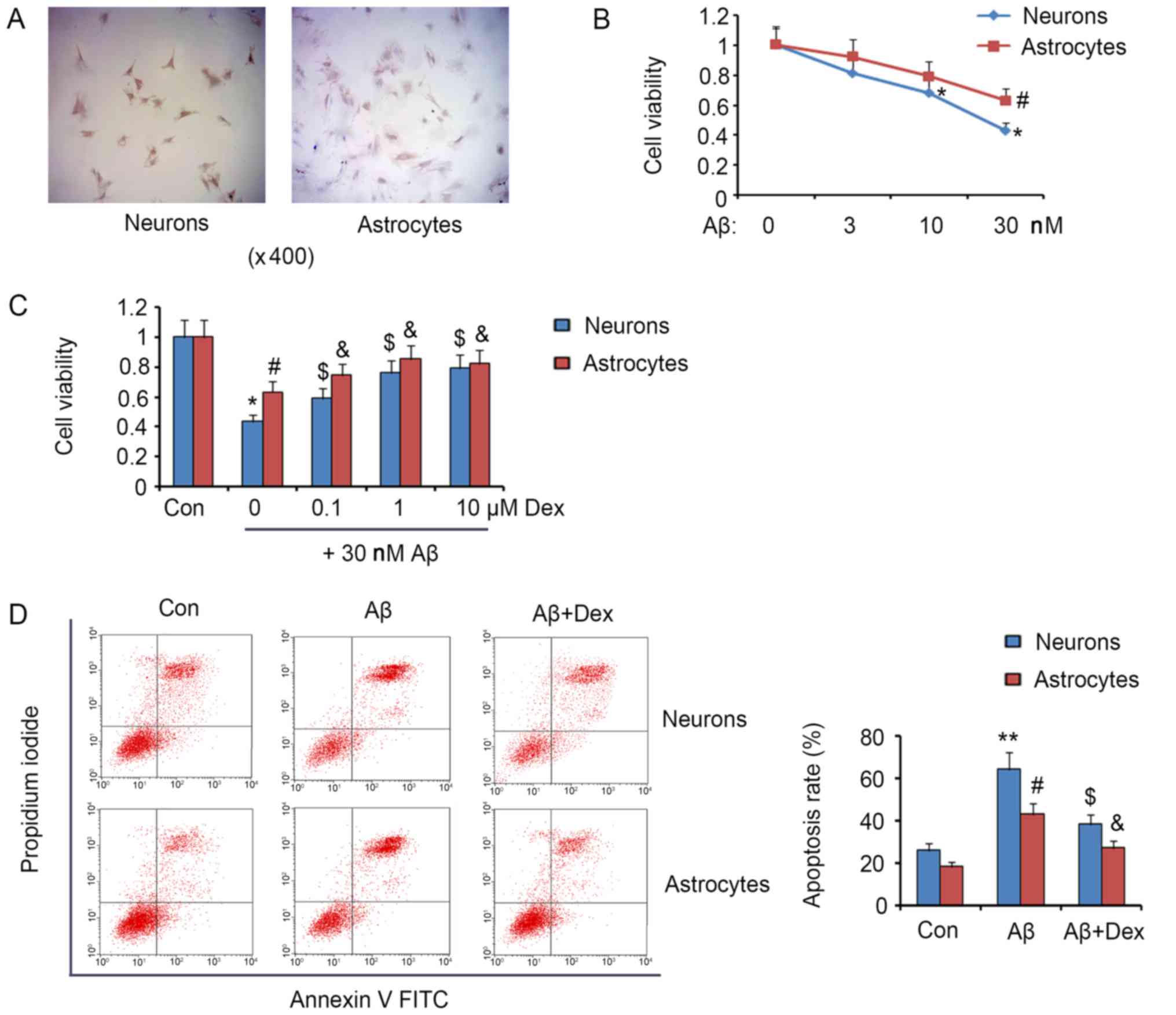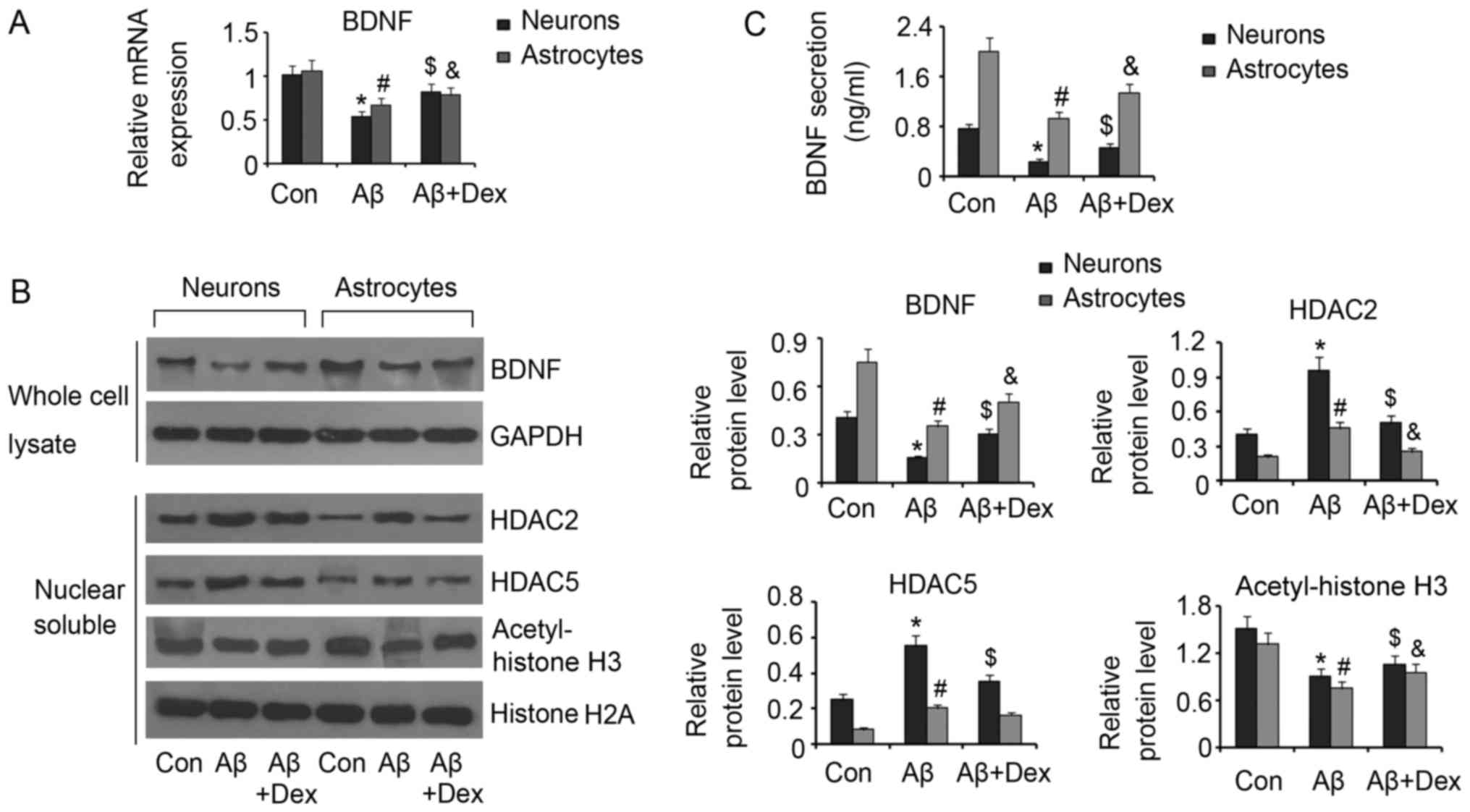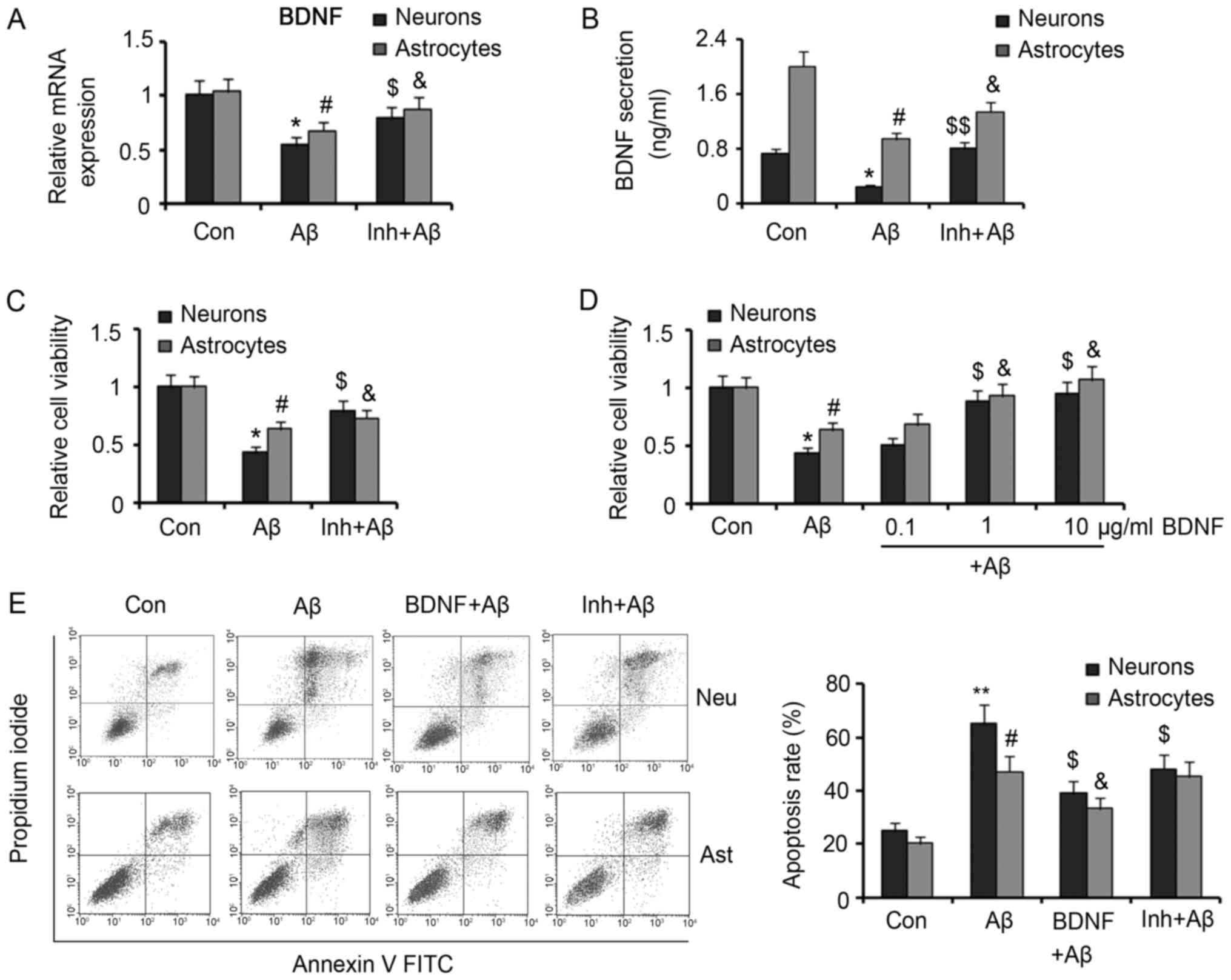|
1
|
Kazim SF and Iqbal K: Neurotrophic factor
small-molecule mimetics mediated neuroregeneration and synaptic
repair: Emerging therapeutic modality for Alzheimer's disease. Mol
Neurodegener. 11:502016. View Article : Google Scholar : PubMed/NCBI
|
|
2
|
Tong L, Balazs R, Thornton PL and Cotman
CW: Beta-amyloid peptide at sublethal concentrations downregulates
brain-derived neurotrophic factor functions in cultured cortical
neurons. J Neurosci. 24:6799–6809. 2004. View Article : Google Scholar : PubMed/NCBI
|
|
3
|
Frost GR and Li YM: The role of astrocytes
in amyloid production and Alzheimer's disease. Open Biol. 7(pii):
1702282017. View Article : Google Scholar : PubMed/NCBI
|
|
4
|
Benussi L, Binetti G and Ghidoni R: Loss
of neuroprotective factors in neurodegenerative dementias: The end
or the starting point? Front Neurosci. 11:6722017. View Article : Google Scholar : PubMed/NCBI
|
|
5
|
Peng S, Wuu J, Mufson EJ and Fahnestock M:
Precursor form of brain-derived neurotrophic factor and mature
brain-derived neurotrophic factor are decreased in the pre-clinical
stages of Alzheimer's disease. J Neurochem. 93:1412–1421. 2005.
View Article : Google Scholar : PubMed/NCBI
|
|
6
|
Buchman AS, Yu L, Boyle PA, Schneider JA,
De Jager PL and Bennett DA: Higher brain BDNF gene expression is
associated with slower cognitive decline in older adults.
Neurology. 86:735–741. 2016. View Article : Google Scholar : PubMed/NCBI
|
|
7
|
Park SY, Shin HK, Lee WS, Bae SS, Kim K,
Hong KW and Kim CD: Neuroprotection by aripiprazole against
β-amyloid-induced toxicity by P-CK2α activation via inhibition of
GSK-3β. Oncotarget. 8:110380–110391. 2017. View Article : Google Scholar : PubMed/NCBI
|
|
8
|
Arancibia S, Silhol M, Moulière F, Meffre
J, Höllinger I, Maurice T and Tapia-Arancibia L: Protective effect
of BDNF against beta-amyloid induced neurotoxicity in vitro and in
vivo in rats. Neurobiol Dis. 31:316–326. 2008. View Article : Google Scholar : PubMed/NCBI
|
|
9
|
Zhang L, Fang Y, Lian Y, Chen Y, Wu T,
Zheng Y, Zong H, Sun L, Zhang R, Wang Z and Xu Y: Brain-derived
neurotrophic factor ameliorates learning deficits in a rat model of
Alzheimer's disease induced by aβ1-42. PLoS One. 10:e01224152015.
View Article : Google Scholar : PubMed/NCBI
|
|
10
|
Yang XJ and Seto E: Lysine acetylation:
Codified crosstalk with other posttranslational modifications. Mol
Cell. 31:449–461. 2008. View Article : Google Scholar : PubMed/NCBI
|
|
11
|
Zhu X, Wang S, Yu L, Jin J, Ye X, Liu Y
and Xu Y: HDAC3 negatively regulates spatial memory in a mouse
model of Alzheimer's disease. Aging Cell. 16:1073–1082. 2017.
View Article : Google Scholar : PubMed/NCBI
|
|
12
|
Sen A, Nelson TJ and Alkon DL: ApoE4 and
Aβ oligomers reduce BDNF expression via HDAC nuclear translocation.
J Neurosci. 35:7538–7551. 2015. View Article : Google Scholar : PubMed/NCBI
|
|
13
|
Tang J and Zhuang S: Epigenetics in acute
kidney injury. Curr Opin Nephrol Hypertens. 24:351–358.
2015.PubMed/NCBI
|
|
14
|
Wang BY, Zhong Y, Zhao Z and Miao Y:
Epigenetic suppression of hippocampal BDNF mediates the memory
deficiency induced by amyloid fibrils. Pharmacol Biochem Behav.
126:83–89. 2014. View Article : Google Scholar : PubMed/NCBI
|
|
15
|
Xie Z, Dong Y, Maeda U, Alfille P, Culley
DJ, Crosby G and Tanzi RE: The common inhalation anesthetic
isoflurane induces apoptosis and increases amyloid beta protein
levels. Anesthesiology. 104:988–994. 2006. View Article : Google Scholar : PubMed/NCBI
|
|
16
|
Zhang S, Hu X, Guan W, Luan L, Li B, Tang
Q and Fan H: Isoflurane anesthesia promotes cognitive impairment by
inducing expression of β-amyloid protein-related factors in the
hippocampus of aged rats. PLoS One. 12:e01756542017. View Article : Google Scholar : PubMed/NCBI
|
|
17
|
Evered L, Scott DA and Silbert B:
Cognitive decline associated with anesthesia and surgery in the
elderly: Does this contribute to dementia prevalence? Curr Opin
Psychiatry. 30:220–226. 2017. View Article : Google Scholar : PubMed/NCBI
|
|
18
|
Bilotta F, Qeva E and Matot I: Anesthesia
and cognitive disorders: A systematic review of the clinical
evidence. Expert Rev Neurother. 16:1311–1320. 2016. View Article : Google Scholar : PubMed/NCBI
|
|
19
|
Wu J, Bie B and Naguib M: Epigenetic
manipulation of brain-derived neurotrophic factor improves memory
deficiency induced by neonatal anesthesia in rats. Anesthesiology.
124:624–640. 2016. View Article : Google Scholar : PubMed/NCBI
|
|
20
|
Ryu YK, Khan S, Smith SC and Mintz CD:
Isoflurane impairs the capacity of astrocytes to support neuronal
development in a mouse dissociated coculture model. J Neurosurg
Anesthesiol. 26:363–368. 2014. View Article : Google Scholar : PubMed/NCBI
|
|
21
|
Liu YJ, Wang DY, Yang YJ and Lei WF:
Effects and mechanism of dexmedetomidine on neuronal cell injury
induced by hypoxia-ischemia. BMC Anesthesiol. 17:1172017.
View Article : Google Scholar : PubMed/NCBI
|
|
22
|
Shen M, Wang S, Wen X, Han XR, Wang YJ,
Zhou XM, Zhang MH, Wu DM, Lu J and Zheng YL: Dexmedetomidine exerts
neuroprotective effect via the activation of the PI3K/Akt/mTOR
signaling pathway in rats with traumatic brain injury. Biomed
Pharmacother. 95:885–893. 2017. View Article : Google Scholar : PubMed/NCBI
|
|
23
|
Zhou C, Zhu Y, Liu Z and Ruan L: Effect of
dexmedetomidine on postoperative cognitive dysfunction in elderly
patients after general anaesthesia: A meta-analysis. J Int Med Res.
44:1182–1190. 2016. View Article : Google Scholar : PubMed/NCBI
|
|
24
|
Hsing CH, Lin CF, So E, Sun DP, Chen TC,
Li CF and Yeh CH: α2-Adrenoceptor agonist dexmedetomidine protects
septic acute kidney injury through increasing BMP-7 and inhibiting
HDAC2 and HDAC5. Am J Physiol Renal Physiol. 303:F1443–F1453. 2012.
View Article : Google Scholar : PubMed/NCBI
|
|
25
|
Dong D, Mao Y, Huang C, Jiao Q, Pan H, Ma
L and Wang R: Astrocytes mediated the nootropic and neurotrophic
effects of Sarsasapogenin-AA13 via upregulating brain-derived
neurotrophic factor. Am J Transl Res. 9:4015–4025. 2017.PubMed/NCBI
|
|
26
|
Institute for laboratory animal research:
Guide for the care and use of laboratory animals. 8th. Washington
(DC): National Academies Press: 2011
|
|
27
|
Livak KJ and Schmittgen TD: Analysis of
relative gene expression data using real-time quantitative PCR and
the 2(-Delta Delta C(T)) method. Methods. 25:402–408. 2001.
View Article : Google Scholar : PubMed/NCBI
|
|
28
|
Koseoglu MM, Ozdilek BA, Djakbarova U and
Gulusur A: Targeting ras activity prevented amyloid beta-induced
aberrant neuronal cell cycle re-entry and death. Curr Alzheimer
Res. 13:1267–1276. 2016. View Article : Google Scholar : PubMed/NCBI
|
|
29
|
Suganthy N, Malar DS and Devi KP:
Rhizophora mucronata attenuates beta-amyloid induced
cognitive dysfunction, oxidative stress and cholinergic deficit in
Alzheimer's disease animal model. Metab Brain Dis. 31:937–949.
2016. View Article : Google Scholar : PubMed/NCBI
|
|
30
|
Hettiarachchi NT, Boyle JP, Dallas ML,
Al-Owais MM, Scragg JL and Peers C: Heme oxygenase-1 derived carbon
monoxide suppresses Aβ1-42 toxicity in astrocytes. Cell Death Dis.
8:e28842017. View Article : Google Scholar : PubMed/NCBI
|
|
31
|
Chay KO, Nam Koong KY, Hwang S, Kim JK and
Bae CS: NADPH oxidase mediates β-amyloid peptide-induced neuronal
death in mouse cortical cultures. Chonnam Med J. 53:196–202. 2017.
View Article : Google Scholar : PubMed/NCBI
|
|
32
|
Oguchi T, Ono R, Tsuji M, Shozawa H, Somei
M, Inagaki M, Mori Y, Yasumoto T, Ono K and Kiuchi Y: Cilostazol
suppresses Aβ-induced neurotoxicity in SH-SY5Y cells through
inhibition of oxidative stress and MAPK signaling pathway. Front
Aging Neurosci. 9:3372017. View Article : Google Scholar : PubMed/NCBI
|
|
33
|
Aguirre-Rueda D, Guerra-Ojeda S, Aldasoro
M, Iradi A, Obrador E, Mauricio MD, Vila JM, Marchio P and Valles
SL: WIN 55,212-2, agonist of cannabinoid receptors, prevents
amyloid β1-42 effects on astrocytes in primary culture. PLoS One.
10:e01228432015. View Article : Google Scholar : PubMed/NCBI
|
|
34
|
Baglietto-Vargas D, Sánchez-Mejias E,
Navarro V, Jimenez S, Trujillo-Estrada L, Gómez-Arboledas A,
Sánchez-Mico M, Sánchez-Varo R, Vizuete M, Dávila JC, et al: Dual
roles of Aβ in proliferative processes in an amyloidogenic model of
Alzheimer's disease. Sci Rep. 7:100852017. View Article : Google Scholar : PubMed/NCBI
|
|
35
|
Ohki EC, Langan TJ, Rodgers KR and Chou
RC: Non-aggregated Aβ25-35 upregulates primary astrocyte
proliferation in vitro. Front Cell Neurosci. 11:3012017. View Article : Google Scholar : PubMed/NCBI
|
|
36
|
Yamanaka D, Kawano T, Nishigaki A, Aoyama
B, Tateiwa H, Shigematsu-Locatelli M, Locatelli FM and Yokoyama M:
Preventive effects of dexmedetomidine on the development of
cognitive dysfunction following systemic inflammation in aged rats.
J Anesth. 31:25–35. 2017. View Article : Google Scholar : PubMed/NCBI
|
|
37
|
Chen SD, Wu CL, Hwang WC and Yang DI: More
Insight into BDNF against Neurodegeneration: Anti-apoptosis,
anti-oxidation, and suppression of autophagy. Int J Mol Sci.
18(pii): E5452017. View Article : Google Scholar : PubMed/NCBI
|
|
38
|
Uchida K, Nakajima H, Hirai T, Yayama T,
Chen K, Guerrero AR, Johnson WE and Baba H: The retrograde delivery
of adenovirus vector carrying the gene for brain-derived
neurotrophic factor protects neurons and oligodendrocytes from
apoptosis in the chronically compressed spinal cord of twy/twy
mice. Spine (Phila Pa 1976). 37:2125–2135. 2012. View Article : Google Scholar : PubMed/NCBI
|
|
39
|
Schizas N, König N, Andersson B,
Vasylovska S, Hoeber J, Kozlova EN and Hailer NP: Neural crest stem
cells protect spinal cord neurons from excitotoxic damage and
inhibit glial activation by secretion of brain-derived neurotrophic
factor. Cell Tissue Res. 372:493–505. 2018. View Article : Google Scholar : PubMed/NCBI
|
|
40
|
Spagnuolo MS, Donizetti A, Iannotta L,
Aliperti V, Cupidi C, Bruni AC and Cigliano L: Brain-derived
neurotrophic factor modulates cholesterol homeostasis and
Apolipoprotein E synthesis in human cell models of astrocytes and
neurons. J Cell Physiol. 11–Jan;2018.(Epub ahead of print).
View Article : Google Scholar : PubMed/NCBI
|
|
41
|
Tapia-Arancibia L, Aliaga E, Silhol M and
Arancibia S: New insights into brain BDNF function in normal aging
and Alzheimer disease. Brain Res Rev. 59:201–220. 2008. View Article : Google Scholar : PubMed/NCBI
|
|
42
|
Rohe M, Synowitz M, Glass R, Paul SM,
Nykjaer A and Willnow TE: Brain-derived neurotrophic factor reduces
amyloidogenic processing through control of SORLA gene expression.
J Neurosci. 29:15472–15478. 2009. View Article : Google Scholar : PubMed/NCBI
|
|
43
|
Arancibia S, Silhol M, Mouliere F, Meffre
J, Höllinger I, Maurice T and Tapia-Arancibia L: Protective effect
of BDNF against beta-amyloid induced neurotoxicity in vitro and in
vivo in rats. Neurobiol Dis. 31:316–326. 2008. View Article : Google Scholar : PubMed/NCBI
|
|
44
|
Peng S, Garzon DJ, Marchese M, Klein W,
Ginsberg SD, Francis BM, Mount HT, Mufson EJ, Salehi A and
Fahnestock M: Decreased brain-derived neurotrophic factor depends
on amyloid aggregation state in transgenic mouse models of
Alzheimer's disease. J Neurosci. 29:9321–9329. 2009. View Article : Google Scholar : PubMed/NCBI
|
|
45
|
Poon WW, Blurton-Jones M, Tu CH, Feinberg
LM, Chabrier MA, Harris JW, Jeon NL and Cotman CW: β-Amyloid
impairs axonal BDNF retrograde trafficking. Neurobiol Aging.
32:821–833. 2011. View Article : Google Scholar : PubMed/NCBI
|
|
46
|
Zhang R, Wang Z, Howson PA, Xia Z, Zhou S,
Wu E, Xia Z and Hu Y: Smilagenin attenuates beta amyloid
(25–35)-induced degeneration of neuronal cells via stimulating the
gene expression of brain-derived neurotrophic factor. Neuroscience.
210:275–285. 2012. View Article : Google Scholar : PubMed/NCBI
|
|
47
|
Takamatsu G, Katagiri C, Tomoyuki T,
Shimizu-Okabe C, Nakamura W, Nakamura-Higa M, Hayakawa T,
Wakabayashi S, Kondo T, Takayama C and Matsushita M: Tescalcin is a
potential target of class I histone deacetylase inhibitors in
neurons. Biochem Biophys Res Commun. 482:1327–1333. 2017.
View Article : Google Scholar : PubMed/NCBI
|
|
48
|
Tang Y, Lin YH, Ni HY, Dong J, Yuan HJ,
Zhang Y, Liang HY, Yao MC, Zhou QG, Wu HY, et al: Inhibiting
histone deacetylase 2 (HDAC2) promotes functional recovery from
stroke. J Am Heart Assoc. 6(pii): e0072362017.PubMed/NCBI
|
|
49
|
Fukui T, Asakura K, Hikichi C, Ishikawa T,
Murai R, Hirota S, Murate K, Kizawa M, Ueda A, Ito S and Mutoh T:
Histone deacetylase inhibitor attenuates neurotoxicity of
clioquinol in PC12 cells. Toxicology. 331:112–118. 2015. View Article : Google Scholar : PubMed/NCBI
|
|
50
|
Asaoka N, Nagayasu K, Nishitani N,
Yamashiro M, Shirakawa H, Nakagawa T and Kaneko S: Inhibition of
histone deacetylases enhances the function of serotoninergic
neurons in organotypic raphe slice cultures. Neurosci Lett.
593:72–77. 2015. View Article : Google Scholar : PubMed/NCBI
|
|
51
|
Suo H, Wang P, Tong J, Cai L, Liu J, Huang
D, Huang L, Wang Z, Huang Y, Xu J, et al: NRSF is an essential
mediator for the neuroprotection of trichostatin A in the MPTP
mouse model of Parkinson's disease. Neuropharmacology. 99:67–78.
2015. View Article : Google Scholar : PubMed/NCBI
|












